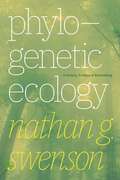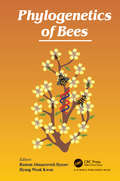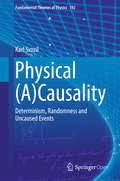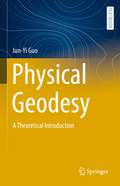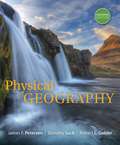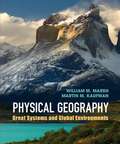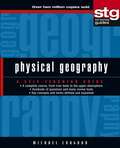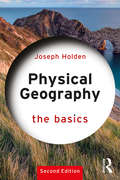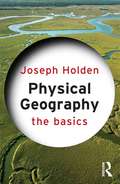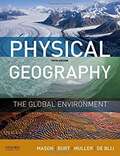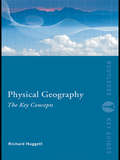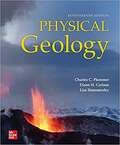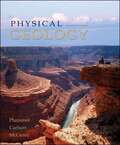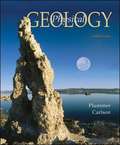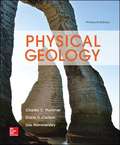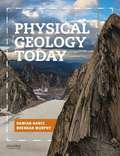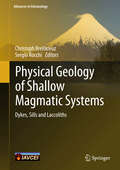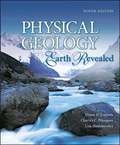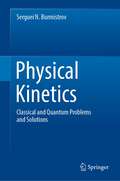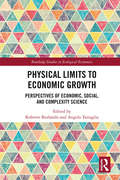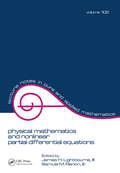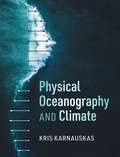- Table View
- List View
Phylogenetic Ecology: A History, Critique, & Remodeling (Use R! Ser.)
by Nathan G. SwensonOver the past decade, ecologists have increasingly embraced phylogenetics, the study of evolutionary relationships among species. As a result, they have come to discover the field’s power to illuminate present ecological patterns and processes. Ecologists are now investigating whether phylogenetic diversity is a better measure of ecosystem health than more traditional metrics like species diversity, whether it can predict the future structure and function of communities and ecosystems, and whether conservationists might prioritize it when formulating conservation plans. In Phylogenetic Ecology, Nathan G. Swenson synthesizes this nascent field’s major conceptual, methodological, and empirical developments to provide students and practicing ecologists with a foundational overview. Along the way, he highlights those realms of phylogenetic ecology that will likely increase in relevance—such as the burgeoning subfield of phylogenomics—and shows how ecologists might lean on these new perspectives to inform their research programs.
Phylogenetics of Bees
by Rustem Abuzarovich Ilyasov Hyung Wook KwonBees are flying insects of the order Hymenoptera closely related to wasps and ants. The ancestors of bees are assumed to be predatory wasps, which switched to pollen consumption. Further, bees co-evolved with flowering plants and divided into several species according to climatic conditions. Widely known bees are western bees Apis mellifera, and eastern bees Apis cerana. This book sheds light on features of evolution, phylogenesis, speciation, adaptation to environment, and taxonomy of bees. It will be of particular relevance to evolutionists, geneticists, taxonomists, ecologists, population geneticist, and breeders.
Physical (A)Causality
by Karl SvozilThis open access book addresses the physical phenomenon of events that seem to occur spontaneously and without any known cause. These are to be contrasted with events that happen in a (pre-)determined, predictable, lawful, and causal way. All our knowledge is based on self-reflexive theorizing, as well as on operational means of empirical perception. Some of the questions that arise are the following: are these limitations reflected by our models? Under what circumstances does chance kick in? Is chance in physics merely epistemic? In other words, do we simply not know enough, or use too crude levels of description for our predictions? Or are certain events "truly", that is, irreducibly, random? The book tries to answer some of these questions by introducing intrinsic, embedded observers and provable unknowns; that is, observables and procedures which are certified (relative to the assumptions) to be unknowable or undoable. A (somewhat iconoclastic) review of quantum mechanics is presented which is inspired by quantum logic. Postulated quantum (un-)knowables are reviewed. More exotic unknowns originate in the assumption of classical continua, and in finite automata and generalized urn models, which mimic complementarity and yet maintain value definiteness. Traditional conceptions of free will, miracles and dualistic interfaces are based on gaps in an otherwise deterministic universe.
Physical Geodesy: A Theoretical Introduction (Springer Textbooks in Earth Sciences, Geography and Environment)
by Jun-Yi GuoThis textbook introduces physical geodesy. It treats the boundary-value theories of the discipline comprehensively, and provides insights to the theory of gravity reduction based on a spherical Earth model. This book is for students who wish to thoroughly understand the material and to expand their knowledge and skills in mathematics for more advanced study and research in this discipline. The details of mathematical derivations included are a useful asset for instructors and researchers.
Physical Geography
by Dorothy Sack James Petersen Robert GablerPHYSICAL GEOGRAPHY, Eleventh Edition, uses the combined expertise of three accomplished and respected geographers to show not only what constitutes physical geography but also the interrelationships between people and Earth's natural environment. The well-written text and excellent illustrations emphasize three essential themes to demonstrate the major roles of the discipline -- Geography as Physical Science, Geography as Spatial Science, and Geography as Environmental Science. With a strong focus on processes and the interrelationships among Earth's systems, this text guides you to an understanding and appreciation of how the various natural systems function and of how humans are an integral component of physical geography. Historically, this was the first Physical Geography textbook to take an environmental sustainability approach, and the authors continue to address the theme of human interactions with the environment.
Physical Geography
by William M. Marsh Martin M. KaufmanThe physical geography of Earth is explained through the systems that shape the planet's lands, waters, and atmosphere. Written in an easy narrative style, each chapter combines text with more than 40 single-concept illustrations. The result is a distinctive design that weaves words and illustrations together into an integrated whole. The presentation is uncluttered to keep students focused on the main themes. An entire chapter is dedicated to climate change, its geographic origins, likely outcomes, and influence on other Earth systems. A distinctive illustration program includes summary diagrams at the end of chapters that recap concepts and reinforce the systems approach. Section summaries within chapters, along with end-of-chapter review points and questions, are provided to highlight key concepts and encourage thoughtful review of the material. The instructor's guidebook highlights the core concepts in each chapter and suggests strategies to advance a systems approach in teaching physical geography.
Physical Geography
by Michael CraghanLearn physical geography at your own pace What is atmospheric pressure? How does latitude indicate the type of climate a specific place will have? Where are volcanic eruptions or strong earthquakes most likely to occur? With Physical Geography: A Self-Teaching Guide, you'll discover the answers to these questions and many more about the basics of how our planet operates. Veteran geography teacher Michael Craghan takes you on a guided tour of Earth's surface, explaining our planet's systems and cycles and their complex interactions step by step. From seasonal changes to coastal processes, from effluvial basins to deep sea fissures, Craghan puts the emphasis on comprehension of the topics. He also includes more than 100 specially commissioned illustrations and 50 photographs to help clarify difficult concepts. The clearly structured format of Physical Geography makes it fully accessible, providing an easily understood, comprehensive overview for everyone from the student to the amateur geographer to the hobbyist. Like all Self-Teaching Guides, Physical Geography allows you to build gradually on what you have learned-at your own pace. Questions and self-tests reinforce the information in each chapter and allow you to skip ahead or focus on specific areas of concern. Packed with useful, up-to-date information, this clear, concise volume is a valuable learning tool and reference source for anyone who wants to improve his or her understanding of physical geography.
Physical Geography: The Basics (The Basics)
by Joseph HoldenThis second edition, enhanced with more than 30 new figures, provides an up-to-date overview of physical geography suitable for all those with a personal or professional interest in environmental processes, climate change and understanding of the Earth’s landforms and dynamics. The text provides explanations of processes, enabling the reader to understand the interconnected nature of the Earth’s system, and has been updated to include new developments and case studies with insights from satellite observations and data analysis using artificial intelligence. The book begins by outlining the nature of the Earth system, concepts around environmental thresholds and feedbacks, planetary boundaries for human survival, and humans as a dominant driver of environmental change. The second chapter examines features associated with plate tectonics, the role of weathering and erosion in shaping landscapes, and soil functions and management. Chapter 3 deals with the climate system, describing drivers of the major atmospheric and oceanic circulation systems, the natural greenhouse effect, and regional climate and weather experienced for different zones across the planet. The global carbon cycle and long-term climate change are considered in Chapter 4 before moving on to tackle the latest knowledge on contemporary and future climate change, its impacts, mitigation and adaptation. Chapter 5 facilitates key understanding of hydrology, river channel dynamics, water quality, coastal processes, glacier dynamics and cold region landforms while Chapter 6 deals with the distribution and patterns of life on Earth and of the underlying processes that result in these patterns. The book concludes with a brief overview of considerations for managing environmental change and hazards, and requirements for achieving the UN’s Sustainable Development Goals. This reader-friendly text brings together wide-ranging subject areas from across physical geography, covering the basics of the subject at a level suitable for those about to embark on a university degree or for those who just want to get a solid basic understanding of the physical environment around them. The book, which contains box features with examples and a glossary to aid understanding, acts as a primer for further study, or in itself can be used as a basic aid to understanding fundamental principles and processes associated with physical geography.
Physical Geography: The Basics (The Basics)
by Joseph HoldenPhysical Geography: The Basics is a concise and engaging introduction to the interactions, systems and processes that have shaped, and continue to shape, the physical world around us. This book introduces five key aspects of the study of physical geography: atmosphere, weather and climate systems the carbon cycle and historic and contemporary climate change plate tectonics, weathering, erosion and soils the role of water and ice in shaping the landscape and impacting human activity the patterns of plant and animal life and human impacts upon them. The book features diagrams, maps and a glossary to aid understanding of key ideas and suggestions for further reading to allow readers to develop their interest in the subject – making Physical Geography: The Basics the ideal starting point for anyone new to the study of geography and the environment.
Physical Geography: The Global Environment
by Harm De Blij Peter Muller Joseph Mason Jason BurtWell known for its flexibility, clarity of presentation, and graphic excellence, Physical Geography: The Global Environment, Fifth Edition, provides a thorough, scientifically authoritative, accessible, and geographic view of Earth's physical systems.
Physical Geography: The Key Concepts (Routledge Key Guides)
by Richard John HuggettPhysical Geography: The Key Concepts is a thought-provoking and up-to-date introduction to the central ideas and debates within the field. It provides extended definitions of terms that are fundamental to physical geography and its many branches, covering topics such as: biogeography ecology climatology meteorology geomorphology hydrology pedology Complete with informative tables, diagrams, and suggestions for further reading, this is a highly accessible guide for those studying physical geography and related courses.
Physical Geology
by Charles C. Plummer Diane H. Carlson Lisa HammersleyPhysical Geologyis a classic introductory text that has helped countless students learn basic physical geology concepts for over 25 years. Students taking introductory physical geology to fulfill a science elective, as well as those contemplating a career in geology, will appreciate the accessible writing style and depth of coverage in Physical Geology.
Physical Geology
by Charles Plummer Diane Carlson David McGearyContains hundreds of illustrations and accompanying photographs which correlate with the chapter descriptions to help readers grasp new geologic concepts. This book also accompanies numerous chapter learning tools and a rich Online Learning Center website which further assist students in their study of physical geology.
Physical Geology (12th Edition)
by Charles C. Plummer Diane H. CarlsonOne excellent reason to read this book is that it's tried and true. Since the book was published in 1979, over 1,000,000 students have read this text as an introduction to physical geology. Proportionately, geology instructors have relied on this text for over 5,000 courses to explain, illustrate, and exemplify basic geologic concepts to both majors and non-majors. Today, the 12th edition continues to provide contemporary perspectives that reflect current research, recent natural disasters, unmatched illustrations, and unparalleled learning aids. We have worked closely with contributors, reviewers, and our editors to publish the most accurate and current text possible.
Physical Geology (Fifteenth Edition)
by Charles C. Plummer Diane H. Carlson Lisa HammersleyPhysical Geology, 15th edition, is the latest refinement of a classic introductory text that has helped countless students learn basic physical geology concepts for over 25 years. Students taking introductory physical geology to fulfill a science elective, as well as those contemplating a career in geology, will appreciate the accessible writing style and depth of coverage in Physical Geology. Hundreds of carefully rendered illustrations and accompanying photographs correlate perfectly with the chapter descriptions to help readers quickly grasp new geologic concepts. Numerous chapter learning tools and a website further assist students in their study of physical geology.
Physical Geology (Fifteenth Edition)
by Charles C. Plummer Diane H. Carlson Lisa HammersleyPhysical Geology, 15th edition, is the latest refinement of a classic introductory text that has helped countless students learn basic physical geology concepts for over 25 years. Students taking introductory physical geology to fulfill a science elective, as well as those contemplating a career in geology, will appreciate the accessible writing style and depth of coverage in Physical Geology. Hundreds of carefully rendered illustrations and accompanying photographs correlate perfectly with the chapter descriptions to help readers quickly grasp new geologic concepts. Numerous chapter learning tools and a website further assist students in their study of physical geology.
Physical Geology Today
by Damian Nance Brendan MurphyPhysical Geology Today combines a deep integration of plate tectonics with an emphasis on conceptual understanding in order to paint an integrated picture of how Earth works. Damian Nance and Brendan Murphy blend clear engaging prose with hundreds of meticulously crafted illustrations to tell a clear and accessible geologic story that introduces the right amount of terminology at the right time.
Physical Geology of Shallow Magmatic Systems: Dykes, Sills And Laccoliths (Advances In Volcanology Ser.)
by Christoph Breitkreuz Sergio RocchiThis book offers a high-level summary of shallow magmatic systems (dykes, sills and laccoliths) to support geoscience master and PhD students, scientists and practicing professionals. The product of the LASI (Laccoliths and Sills conference) workshop, it comprises thematic sections written by one or more experts on the respective field. It features reviews concerning the physical properties of magma, geotectonic settings, and the structure of subvolcanic systems, as well as case studies on the best-known systems. The book provides readers a broad and comprehensive understanding of the subvolcanic perspective on pluton growth, which is relevant for mineralogical processes as well as the genesis of mineral deposits.
Physical Geology: Earth Revealed, Ninth Edition
by Charles C. Plummer Diane H. Carlson Lisa HammersleyThe ninth edition has been updated to include the most current information from the various sub-disciplines that comprise physical geology. The book's purpose is to clearly present geologic processes so that students can understand the logic of scientific methods. This text features an outstanding art program and a proven, accessible writing style.
Physical Geology: Exploring the Earth (2nd edition)
by Reed Wicander James S. MonroeTextbook on physical geology
Physical Kinetics: Classical and Quantum Problems and Solutions
by Serguei N. BurmistrovThis book includes problems based on the material in the course of physical kinetics for the students of general and applied physics. It contains 60 problems with detailed solutions. The comments to the problems reflect the connection with the problems and methods of modern physical kinetics. A brief introduction gives the necessary information for solving and understanding the problems. The book is proposed for students and postgraduates studying the theoretical physics. The book is used as a supplement to the textbooks published on physical kinetics. The purpose of the book is to help students in training the practical skills and mastering the basic elements of physical kinetics. To understand the subject matter, it is sufficient to know the traditional courses of theoretical physics.
Physical Limits to Economic Growth: Perspectives of Economic, Social, and Complexity Science (Routledge Studies in Ecological Economics)
by Angelo Tartaglia Roberto BurlandoThe debate on the physical limits and constraints to the economic growth of globalized society is now widespread. This book explores the physical and economic aspects of the conflict between humans, with their thoughtless focus on growth through material production, and environmental constraints. In the context of the looming shortage of material resources and the latest science on climate change, Physical Limits to Economic Growth offers new insights which provide a broad and comprehensive picture of the conflict between humans and environmental constraints. The authors’ approach goes beyond the boundaries of specialized disciplines to explore climate change, resource depletion, technical innovation and the interactions between these within the socio-economic-institutional systems we live in. This volume looks at opportunities for rethinking these systems if we moved away from fossil fuel dependence, while considering the status of current mainstream economic thinking around this subject. Physical Limits to Economic Growth provides a genuine interdisciplinary examination of the physical limits to economic growth. It will be of interest to both students and academics in various disciplines in the areas of natural sciences, climate change and economics.
Physical Mathematics
by Kevin CahillUnique in its clarity, examples and range, Physical Mathematics explains as simply as possible the mathematics that graduate students and professional physicists need in their courses and research. The author illustrates the mathematics with numerous physical examples drawn from contemporary research. In addition to basic subjects such as linear algebra, Fourier analysis, complex variables, differential equations and Bessel functions, this textbook covers topics such as the singular-value decomposition, Lie algebras, the tensors and forms of general relativity, the central limit theorem and Kolmogorov test of statistics, the Monte Carlo methods of experimental and theoretical physics, the renormalization group of condensed-matter physics and the functional derivatives and Feynman path integrals of quantum field theory.
Physical Mathematics and Nonlinear Partial Differential Equations
by James H. LightbourneThis volume consists of the proceedings of the conference on Physical Mathematics and Nonlinear Partial Differential Equations held at West Virginia University in Morgantown. It describes some work dealing with weak limits of solutions to nonlinear systems of partial differential equations.
Physical Oceanography and Climate
by Kris KarnauskasClimate research over recent decades has shown that the interaction between the ocean and atmosphere drives the global climate system. This engaging and accessible textbook focuses on climate dynamics from the perspective of the upper ocean, and specifically on the interaction between the atmosphere and ocean. It describes the fundamental physics and dynamics governing the behavior of the ocean, and how it interacts with the atmosphere, giving rise to natural climate variability and influencing climate change. Including end-of-chapter questions and turn-key access to online, research-quality data sets, the book allows readers the chance to apply their knowledge and work with real data. Comprehensive information is also provided on the data sets used to produce the numerous illustrations, allowing students to dive deeper into the data themselves. Providing an accessible treatment of physical oceanography, it is perfect for intermediate-advanced students wishing to gain an interdisciplinary introduction to climate science and oceanography.
